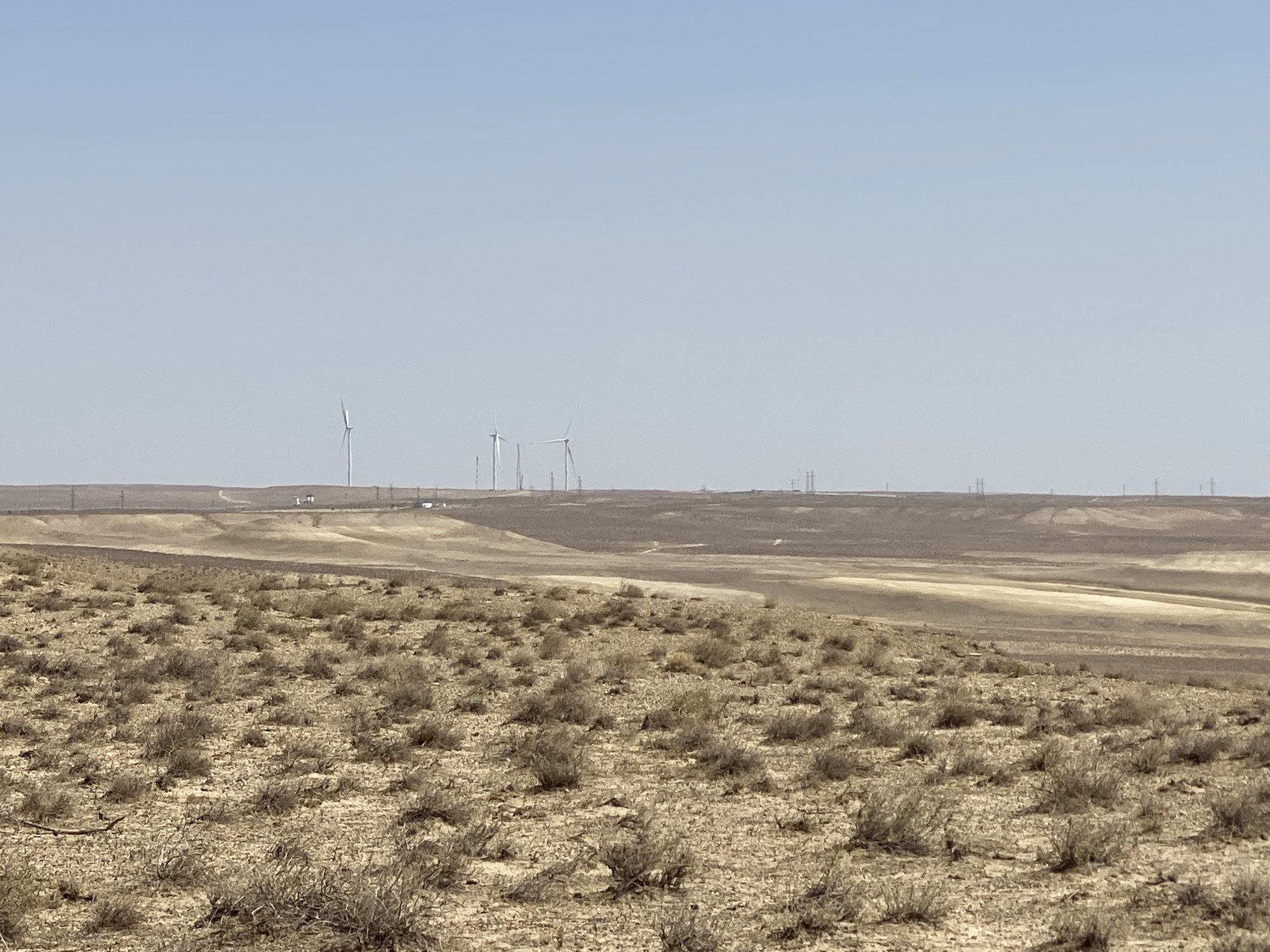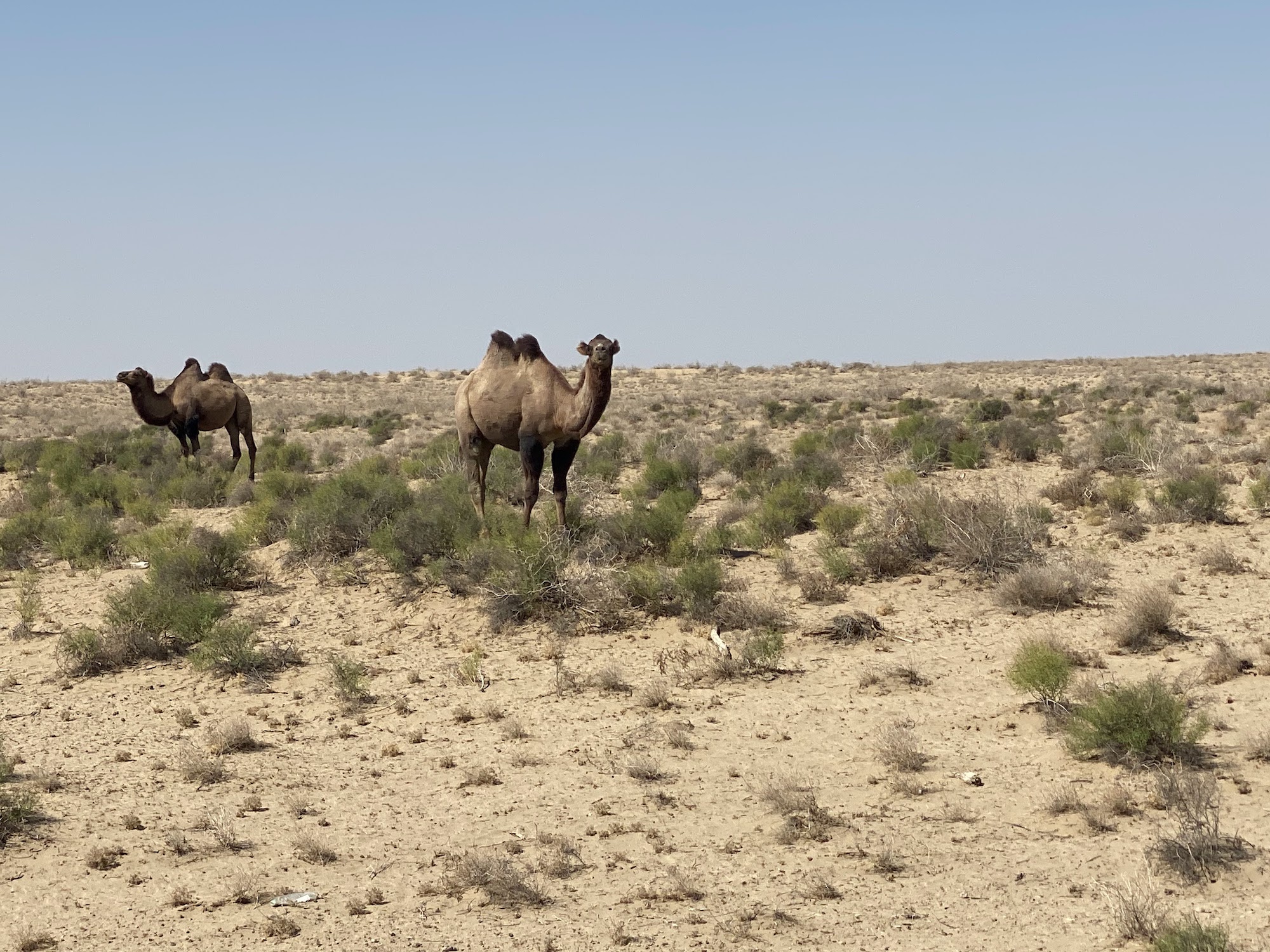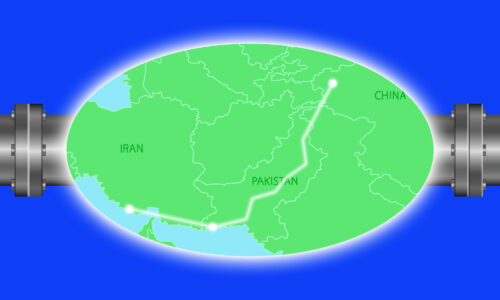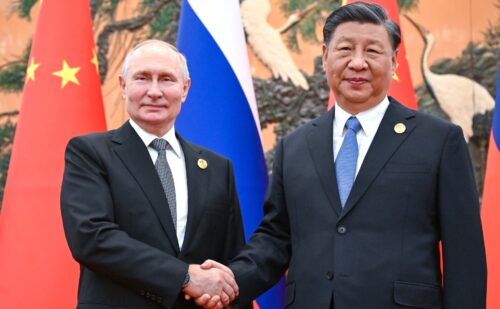BRI at 10: Checking in on the ‘green silk road’
The “green silk road” is a sustainability-flavored subtheme to the Belt and Road Initiative, designed to burnish Beijing’s green credentials and advance its claims to global leadership on environmental topics. It is also contributing to a wealth of renewable energy projects in Central Asia.

This is part 3 of our Belt and Road Dispatch.
- The role of Chinese companies
- China’s soft power ambitions
- China’s role in green technologies
- The Maritime Silk Road

The name of the salt lake, “Ayakagytma,” means “don’t tread” in Kazakh — according to the Russian internet, anyway. But my guide, Shuhrat, tells me that the name refers to the water’s power to treat rheumatism.
On the ground, the internet version checks out — approaching the edge of the lake I begin to sink into sticky salt mud, and I stumble backwards, my shoes now caked in black sludge.
Beyond the muddy edges of the huge salt lake, everything is bone dry. We’re on the southeastern edge of the great Kyzylkum Desert, in the Bukhara Region of Uzbekistan, and until recently, there wasn’t much to see here except desert, salt, and the occasional herd of camels. Nowadays though, visitors to Ayakagytma can also catch a glimpse of giant wind turbines, positioned to take advantage of the fast winds flowing over the desert.

The first time Xí Jìnpíng 习近平 mentioned a “green silk road” in a major public speech was in June 2016, in Uzbekistan, a country that is now rapidly developing its renewable energy capacity with the help of Chinese companies.
There’s a “digital silk road” and a “health silk road,” so it shouldn’t come as a surprise that Beijing also has a “green silk road” focused on sustainable development.
Just like the wider Belt and Road Initiative (BRI), the contours of this green silk road are hard to pin down. The BRI does not have a blueprint, nor project pipeline, and the same goes for the green silk road. The BRI itself is a marketing slogan for China’s overseas footprint, and the green silk road is a sustainability-flavored subtheme, designed to burnish Beijing’s green credentials and advance its claims to global leadership on environmental topics.
But despite this ambiguous, ad-hoc nature, efforts to green the BRI, or at least portray the initiative as green, have been coordinated at the very top. High-level calls to build a “green silk road” began almost as soon as the BRI was announced in 2013, but efforts to rebrand the BRI as green began in earnest around the time of the first International Belt and Road Forum in 2017, when Xi Jinping announced a “big data service platform on ecological and environmental protection” and an “international coalition for green development on the Belt and Road.” The same year, the Chinese Ministry for Ecology and Environment (MEE) issued a sweeping manifesto for sustainable development within the initiative, the “Guidance on Promoting Green Belt and Road.”
Since 2017, Beijing has released a steady stream of official guidelines and schemes aimed at making BRI projects more sustainable. The jury is still out on the extent to which these efforts constitute genuine progress vs. “greenwashing.” Green development guidelines published by the Chinese ministries of commerce and environment have been well received by international experts, but they lack teeth, and initiatives like Xi’s “big data service platform” have amounted to little.
The slow trek from coal to renewables
Beyond environmental risk management, there is also the issue of which projects are built under the BRI umbrella — whether the initiative facilitates new renewable energy capacity or locks developing countries into a carbon dominated future. Until quite recently, Chinese policy banks were among the few international financial institutions still lending for coal fired power plants, but in 2021 Xi Jinping announced at the United Nations that China would stop financing coal overseas. According to the 2022 update of the China’s Global Power database from Boston University, coal fired power plants represent the greatest share (34%) of power plants financed through Chinese investments and loans globally, with solar and wind projects at a combined total of just 12%.
Beijing has largely stuck to the 2021 coal moratorium (with some exceptions), but we haven’t yet seen a surge in renewable energy investment to compensate. Instead, Chinese overseas investments in gas-related projects, which Beijing sometimes markets as “green,” grew in 2022.
Despite this patchy performance in greening the BRI, China’s domination of renewable energy markets make it an inevitable leader of the global green transition. China accounts for 72% of solar and 50% of wind turbine manufacturing worldwide; it boasts an efficient, low-cost renewable supply chain; and its companies are well established internationally as Engineering, Procurement, and Construction (EPC) contractors in renewables.

Chinese state media is quick to highlight the prominent role of Chinese equipment and companies in Central Asia: “Braving wind and sun, camel caravans trekked along the ancient Silk Road, taking silk and tea from China to Central Asia and Europe more than 1,000 years ago. Now, clean energy products are delivered to Belt and Road countries via freight trains and flights, turning wind and sunshine into treasure.”
Renewable energy projects being developed in Uzbekistan do not, however, feature much Chinese finance. Since 2019, Uzbekistan has been rapidly expanding its solar and wind capacity on the basis of public-private partnerships (PPP), a model that involves the developer taking financial responsibility for the project. Chinese investors have been competing in auctions for these renewable power concessions, but they haven’t been winning. Instead, they have been involved as contractors and suppliers of equipment. In fact, despite lagging behind in the auctions, Chinese companies are working as the principle contractors in almost every renewable energy project being rolled out in Uzbekistan.
Chinese projects in Central Asia
The turbines installed along the eastern shore of Ayakagytma are manufactured by the Chinese company Envision. The blades for these 6.5 MW turbines were transported in a truck convoy from Xinjiang by Chinese logistics company Sinotrans, which had to renovate the dry port at the Kazakhstan-Uzbekistan border to allow the trucks, each as long as a soccer field, to turn. One hundred fifty-eight of these turbines are going to be installed by China Energy Engineering Group (CEEC) (中国能源 zhōngguó néngyuán) as part of the Bash and Dzhankeldy wind projects.
Despite all the Chinese trucks, turbines, and engineering work, the Bash and Dzankeldy projects are neither developed nor financed — besides a small commercial Chinese loan — by Chinese institutions. Instead, they are truly international, being developed by Saudi Arabian company ACWA Power and involving finance from institutions such as the European Bank for Reconstruction and Development (EBRD), the Asian Development Bank (ADB), French and German state development funds, the financial institution of the Organization of the Petroleum Exporting Countries (OPEC), and the Industrial and Commercial Bank of China (ICBC). The EBRD is providing the largest sum of money — $300 million — directly from their coffers.
As we explored in the first installment of this series, infrastructure projects don’t need to be financed by Chinese banks to be counted by Beijing as part of the Belt and Road Initiative. Despite the international focus on Belt and Road-related loan financing, these loans are mostly a means to winning contracts for Chinese companies.
Last month, CEEC even teamed up with state media tabloid Global Times to provide live, behind-the-scenes footage of the Bash project site, allowing “netizens from around the world” to “experience up close the practical actions taken by Chinese enterprises to promote global green and low-carbon development, and witness the progress of the Belt and Road Initiative.”
Combined, the Bash and Dzankeldy projects have a capacity of 1 GW — not in the top 10 of largest wind farms, but certainly very significant, even from a global perspective. For context, 15.4 GW of wind capacity was installed throughout the entire European Union in 2019.
That same year, 2019, Uzbekistan had around 16 GW of total energy capacity installed: 14 GW of fossil fuel burning plants, 2 GW of hydropower, and negligible solar and wind capacity. Uzbekistan is rich in coal, oil, and gas reserves, but its aging energy infrastructure makes it vulnerable to power outages, and it is one of the most energy and carbon intensive economies on the planet.
An emerging Gulf-China partnership?
In recent years, the government in Tashkent has moved quickly to shift its energy profile toward renewables. In 2019 the President of Uzbekistan, Shavkat Mirziyoyev, issued a decree to overhaul Uzbekistan’s energy system. The country also adopted two new laws, “on the use of renewable energy sources” and “on public-private partnership,” with the aim of accelerating Uzbekistan’s renewable energy development. Uzbekistan’s goal is to build 10 GW of new renewable energy capacity by 2030, taking the share of renewables in the country’s energy mix from effectively zero to 25%.
Chinese companies have been participating in the auctions for these renewable energy projects, but they haven’t had much success so far. Instead, two companies from the Arabian Gulf — Saudi ACWA Power and Masdar Clean Energy — have dominated Uzbekistan’s renewable energy auctions. Besides the 1GW Bash and Dhankeldy wind projects, ACWA is building the Kuratau wind farm (100 MW). They were also awarded a 1.5 GW wind project in Karakalpakstan, and 1.4 GW of solar in the Tashkent region. For all of these projects, they are partnering with CEEC, or in the case of Kuratau, with another Chinese company, Shanghai Electric.
Meanwhile, Masdar is building Zarafshan wind farm (500 MW) with the help of Chinese company SEPCO III, with turbines from Xinjiang Goldwind. It also has a 457 MW solar project in Sherebad, contracted to Chinese company CMEC, and two 220 MW solar plants in Jizzakh and Samarkand, both contracted to Chinese company Dongfang Electric. Nur Navoi is another smaller, 100 MW solar project, developed by Masdar and also contracted to SEPCO III.
One of the few renewable energy projects in Uzbekistan not being built with a Chinese contractor is a 134 MW development in Samarkand by French company Total Eren, which is being built by Metka EGN, a Greek company.
The ACWA-CEEC and Masdar-SEPCO III pairings are indicative of an emerging Gulf-China nexus in renewables and the Belt and Road more widely. Beijing has in recent years been heavily courting the rich petro states in the Arabian Gulf, and this partnership comes at an opportune time for the BRI. Chinese policy banks are more reluctant nowadays to extend loans for BRI projects, but as the partnerships in Uzbekistan demonstrate, Chinese companies can also rely on others to help build out the “green silk road.”
In the case of ACWA Power, there is ultimately Chinese money involved too. The Silk Road Fund — a Chinese investment fund with the stated goal of promoting “high-quality development of the Belt and Road” — acquired a 49% stake in ACWA Power’s renewable energy arm back in 2019, and ACWA, the Silk Road Fund, and CEEC also partnered up to build a 1.5 GW gas power plant in Uzbekistan.
The domination of Chinese companies in Uzbekistan’s green transition is also a potential concern for European investors. Many of the new solar and wind projects in Uzbekistan are being partly bankrolled by the European Bank for Reconstruction and Development (EBRD), as well as the German and French state development funds. There are concerns about the opacity of Chinese solar supply chains and the potential human rights implications of using Chinese equipment, but the dynamic is also problematic in the context of increasing rivalry and competition between China and the EU.
The EU’s Global Gateway initiative was launched in 2021 as a strategic counter to the BRI, and one of its main objectives is to push forward the green transition globally. China’s domination of renewable energy supply chains means that large chunks of European funds for sustainable development globally will inevitably contribute to the revenue streams of Chinese companies, a dynamic slightly at odds with the narrative of rivalry and competition.






